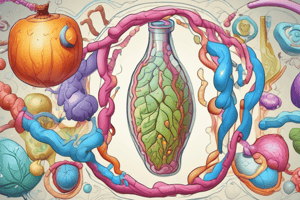Podcast
Questions and Answers
Where does fatty acid synthesis occur and what type of process is it?
Where does fatty acid synthesis occur and what type of process is it?
Anabolic process that occurs in the cytoplasm, primarily in the liver and adipose tissue.
What are the substrates for fatty acid synthesis?
What are the substrates for fatty acid synthesis?
Acetyl-CoA & ATP derived from glucose and NADPH from the pentose phosphate pathway.
What is the product of fatty acid synthesis?
What is the product of fatty acid synthesis?
Saturated palmitate (16:0), which can become unsaturated through elongation/desaturation.
How many ATPs are expended in order to produce a palmitate molecule from acetyl-CoA?
How many ATPs are expended in order to produce a palmitate molecule from acetyl-CoA?
What are the three parts of fatty acid synthesis?
What are the three parts of fatty acid synthesis?
Where does oxidative degradation of a fatty acid molecule begin?
Where does oxidative degradation of a fatty acid molecule begin?
What is the function of fatty acid synthase?
What is the function of fatty acid synthase?
During the course of fatty acid synthesis, the growing acyl group is transferred between which two molecules?
During the course of fatty acid synthesis, the growing acyl group is transferred between which two molecules?
What is the stoichiometry for the synthesis of palmitate from acetyl-CoA?
What is the stoichiometry for the synthesis of palmitate from acetyl-CoA?
What is the 'committed' step of fatty acid synthesis and what enzyme catalyzes it?
What is the 'committed' step of fatty acid synthesis and what enzyme catalyzes it?
What cofactor does acetyl-CoA carboxylase require for its activity?
What cofactor does acetyl-CoA carboxylase require for its activity?
What does the citrate cleavage pathway provide for lipogenesis?
What does the citrate cleavage pathway provide for lipogenesis?
What are the two roles of citrate in fatty acid synthesis?
What are the two roles of citrate in fatty acid synthesis?
What is the function of pyruvate carboxylase?
What is the function of pyruvate carboxylase?
What characteristics do 'carboxylase' enzymes share?
What characteristics do 'carboxylase' enzymes share?
What is the difference between fatty acid synthase in mammals and bacteria?
What is the difference between fatty acid synthase in mammals and bacteria?
Why is the condensation of the acetyl group to the malonyl group energetically favorable?
Why is the condensation of the acetyl group to the malonyl group energetically favorable?
What carbon atoms of palmitate are contributed by one acetyl-CoA used in fatty acid synthesis?
What carbon atoms of palmitate are contributed by one acetyl-CoA used in fatty acid synthesis?
What occurs during beta-oxidation of a fatty acid?
What occurs during beta-oxidation of a fatty acid?
What reactions are performed in beta-oxidation and what molecules are used?
What reactions are performed in beta-oxidation and what molecules are used?
Flashcards are hidden until you start studying
Study Notes
Fatty Acid Synthesis Overview
- Fatty acid synthesis is an anabolic process primarily occurring in the cytoplasm of liver and adipose tissue.
- It involves transforming acetyl-CoA into fatty acids, primarily producing palmitate (16:0).
Substrates and Products
- The main substrates for synthesis are acetyl-CoA, ATP, and NADPH derived from glucose metabolism.
- The product of this synthesis is predominantly saturated palmitate.
Energy Requirement
- To synthesize one molecule of palmitate from acetyl-CoA, 7 ATP are expended.
Steps of Fatty Acid Synthesis
- The process involves:
- Transporting acetyl-CoA to the cytoplasm via the citrate shuttle.
- Activation of acetyl-CoA by acetyl-CoA carboxylase.
- Synthesis mediated by fatty acid synthase.
Oxidative Degradation
- The degradation of fatty acids initiates at the carboxyl end of the molecule.
Fatty Acid Synthase Function
- Fatty acid synthase is a dimeric enzyme that catalyzes the addition of 2-carbon units from acetyl-CoA to the fatty acid chain, functioning independently of ATP.
Acyl Group Transfer
- During synthesis, the growing acyl group is transferred between an acyl carrier protein and a cysteine side chain on fatty acid synthase.
Stoichiometry of Palmitate Production
- The synthesis reaction is:
- 8 acetyl-CoA + 7 ATP + 14 NADPH → palmitate + 14 NADP+ + 8 CoA + 6 H2O + 7 ADP.
Committed Step
- The committed step involves the formation of malonyl-CoA from acetyl-CoA, mediated by acetyl-CoA carboxylase, requiring ATP and bicarbonate.
Acetyl-CoA Carboxylase Requirements
- Activity of acetyl-CoA carboxylase necessitates a biotin cofactor.
Citrate Cleavage Pathway
- The citrate cleavage pathway generates acetyl-CoA and NADPH for lipogenesis through cleavage of citrate transported into the cytosol from the TCA cycle.
Roles of Citrate in Synthesis
- Citrate is cleaved into acetyl-CoA and oxaloacetate and acts as an allosteric activator of acetyl-CoA carboxylase.
Pyruvate Carboxylase Function
- Pyruvate carboxylase converts pyruvate to oxaloacetate, replenishing what is lost during citrate transport and also producing NADPH.
Characteristics of Carboxylase Enzymes
- Carboxylase enzymes generally utilize ATP for adding a carboxylate group to substrates, with biotin as a crucial cofactor.
Differences between Mammalian and Bacterial Fatty Acid Synthase
- In mammals, fatty acid synthase is a single multifunctional protein, whereas in bacteria, it consists of a complex of several proteins.
Energetics of Acetyl and Malonyl Group Condensation
- The condensation of acetyl and malonyl groups is energetically favorable due to the release of CO2, which contributes to the free energy of the reaction.
Contribution of Acetyl-CoA Carbons
- The directly used acetyl-CoA provides the last two carbon atoms (15 and 16) of the palmitate fatty acid chain.
β-Oxidation Process
- During β-oxidation, two-carbon fragments are enzymatically cleaved from the carboxyl end of the fatty acid, converting it into a β-keto acid through a series of oxidation, hydration, and thiolysis reactions.
Reactions and Molecules in β-Oxidation
- Key reactions performed include oxidation by FAD, hydration with H2O, oxidation by NAD+, and thiolysis by Coenzyme A.
Studying That Suits You
Use AI to generate personalized quizzes and flashcards to suit your learning preferences.



